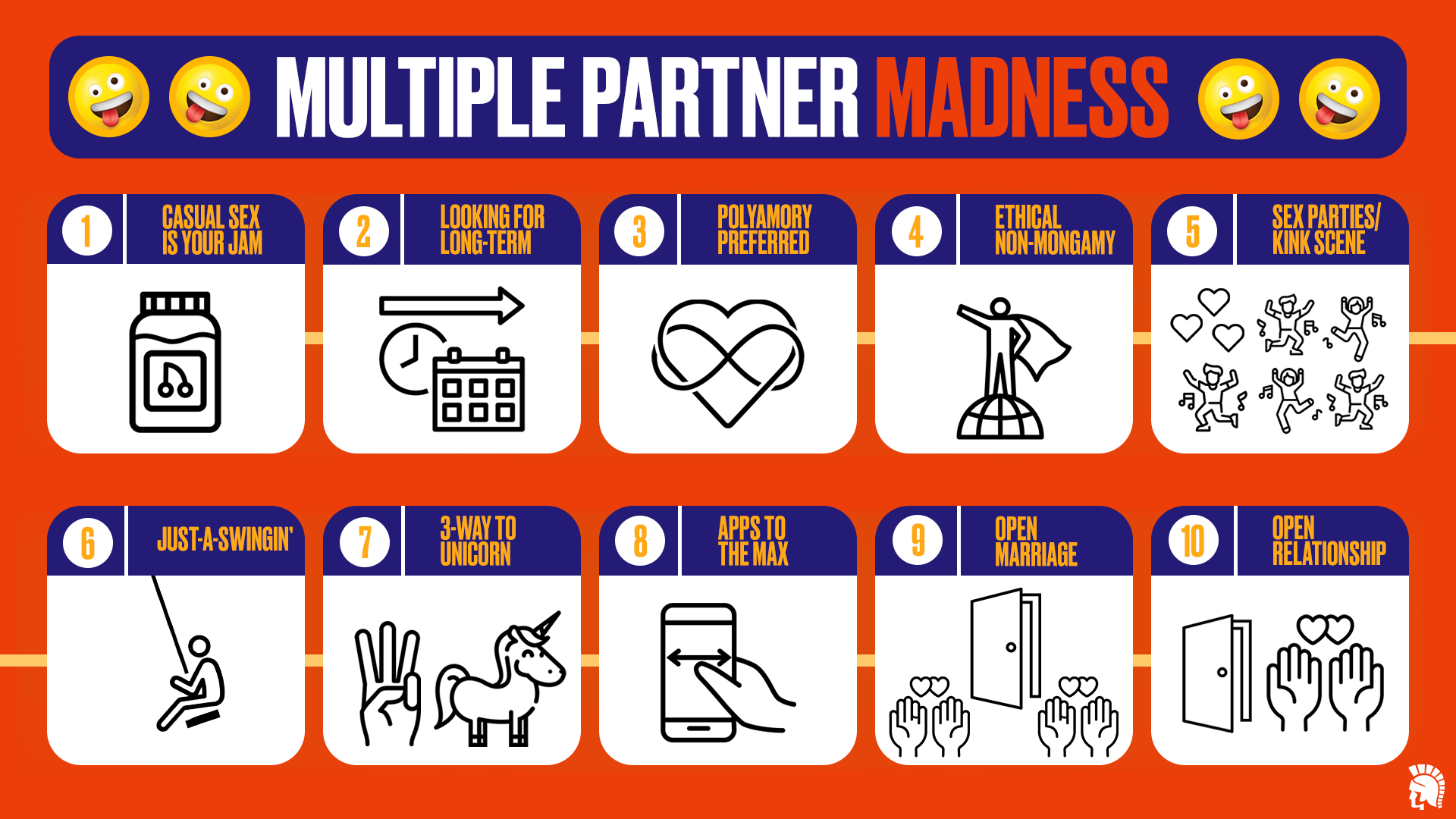Health + Wellness
Non-monogamy: Risks and Benefits of Multiple Sex Partners

Our society usually focuses on monogamous relationships and assumes that all people want to find one sexual and romantic partner and mate for life. It’s true that most people practice monogamy in that they only have one partner at a time, whether that’s for a few months, a few years, or a lifetime. Some people, however, prefer to have more than one partner (romantic and/or sexual) at the same time.
When done with the consent of everybody involved, this is sometimes called ethical non-monogamy (ENM). ENM can take many forms from casual hook-ups (you’re having sex with multiple people at once but not in a relationship with any of them), to open relationships (you have a partner but agree that one or both of you can have sex outside of the relationship), to polyamory (you have more than one romantic/sexual partner at the same time). For more possible arrangements, read about different types of relationships.
Non-monogamy can be complicated because there are more people and more emotions to balance, and it does come with more potential exposure to STIs. This article will discuss those risks, but also the potential benefits of having multiple partners and provide some tips for talking to partners about non-monogamy.
Is having multiple sexual partners the same as cheating?
No. Having multiple sex partners is not cheating as long as everyone involved is aware of the situation and has agreed to the same set of “rules.” Ethical non-monogamy requires honesty, consent, and some planning to make sure that all partners are in agreement, and everyone is safe and protected from pregnancy and STIs.
If you are being honest with all of your partners (and they’re being honest with all of their partners), nobody is cheating.
When/why might you want to have multiple partners?
Choosing to have multiple sex partners is a personal decision that can be based on your stage of life, beliefs, personal goals, and sexual desires. It may be about the kind of relationship you want (now and in the future), or it may be about the sex.
Maybe you’re in between monogamous relationships, haven’t found the right person yet, or met more than one person you’re really into. Maybe you don’t believe that one partner can or should be your everything. Or, you found a great romantic/life partner, but the sex isn’t quite working. Perhaps you simply enjoy dating apps like Grindr and Tinder and the casual sex that follows.
You get to decide. There may be times in your life when you choose monogamy and other times when having multiple partners is a better fit.

Defining multiple partners and open relationships for yourself.
All sexual relationships involve negotiations—it’s not like buying a house, there’s no paperwork or credit checks—but partners have to decide together what they want to do, how often they want to do it, and what steps they’ll take to protect each other.
Deciding whether it’s okay to have other partners now or in the future is an important part of this negotiation. Here are some things to keep in mind as you figure out what works best for you:
Be honest. Anything goes as long as everyone consents, but consent only counts if everyone is operating with the same set of facts. Let all of your sex partners know that there are others.
Be specific. We have a tendency to use generalizations or even euphemisms when talking about sex to avoid embarrassment or hurt feelings, but that’s a recipe for more embarrassment and hurt feelings. Let’s say you tell your partner, “You know, I’m seeing other people, right?” That could mean anything from going to dinner and a movie with someone else every Saturday night to having a handful of other sex partners. In this case, specificity is important.
Be clear. If there are limits to what you’re okay with, you have to let your partners know. This includes the sexual and the emotional. Some people in open relationships, for example, are fine with their partner having casual sex with others but would not be okay if their partner got into another emotionally meaningful relationship.
Be kind. While some people might be excited at the prospect of multiple partners, casual sex, or open relationships—others may hear it as a kind of rejection, a signal that they are not enough. Be gentle when you explain what you want and be prepared for partners who would prefer to walk away than share you with others. That’s their right.
It's also important to remember that relationships change, and all partners are allowed to change their minds about what they are okay with at any time. Ongoing honest communication is the best way to prevent jealousy, anger, and hurt feelings.
What are the benefits of having multiple sexual partners?
Sex is a good thing. It can help you sleep, reduce stress levels, and improve your physical health. More sex could be a better thing. Plus, different people do different things in bed— having sex with more than one person can let you have a variety of experiences and learn what you like most.
Having other sexual outlets can be healthy for people in relationships. Maybe you and a partner have great sex but libidos that just don’t match (one of you wants it far more often than the other) or maybe one of you has a kink that the other does not want to explore. ENM can help everyone feel satisfied without guilt or resentment.
What are the risks of having multiple partners?
Anything that can happen in a sexual relationship with one person—like pregnancy, hurt feelings, or emotional distress—can happen if you’re having sex with more than one person. The real increased risk of having multiple partners at the same time, however, is exposure to STIs.
The more sexual partners you have over the course of your lifetime, the more exposure you may have to STIs, especially if you’ve had unprotected sex. Having multiple partners in the same period of time can increase this risk even further because the germs can spread from one partner to another before anyone realizes they are infected. If each partner has multiple partners, STIs can spread even faster and farther.
Here are some tips for protecting yourself and your partners
Practice safer sex. Latex condoms reduce the risk of STIs when used consistently and correctly. Use them every time from start to finish.
Vaccines & Medications: There are vaccines for some STIs like HPV; check with your health care provider to see if you’ve had all of the recommended vaccines. If you or any of your partners are at risk for HIV, also ask about PrEP, a medication that reduces the chance of getting HIV through sex by about 99%.
Share Carefully. The mantra “sharing is caring” doesn’t apply to sex toys, especially when you have multiple partners. Make sure to wash all of your sex toys carefully between uses. Soap and water are usually sufficient, but you should read the cleaning instructions for the specific sex toy. Additionally, you should never use the same condom with multiple partners.
Get tested. A lot of STIs have no symptoms. The only way to know that you have them is to get tested. Regular STI testing and treatment when needed can help keep you, all of your partners, and all of their partners safer.
Don’t forget contraception. If you or any of your partners are at risk of pregnancy, you should also discuss your birth control options. Condoms are a good option—they are 98% effective against pregnancy when used consistently and correctly—that are always available and easy to come by. Some couples choose long-term options like IUDs or implants, and some feel safest using condoms plus another method.
Be honest. Everyone needs to assess their own STI risk and take the measures that make them feel comfortable. The number of sexual partners each of your partners has right now is an important part of this calculation. It’s not fair to provide incomplete or inaccurate information.
Celebrate your sexuality with the partners of your choice
We are all sexual beings, and we all get to decide how we express that sexuality. For some people it may be having one partner for decades while for others it may be having a new partner every few months for decades. It’s also okay to have multiple partners at the same time.
The keys to ENM are honesty, choice, and consent. As long as everyone consents—and everyone practices safer sex—more certainly can be merrier.






